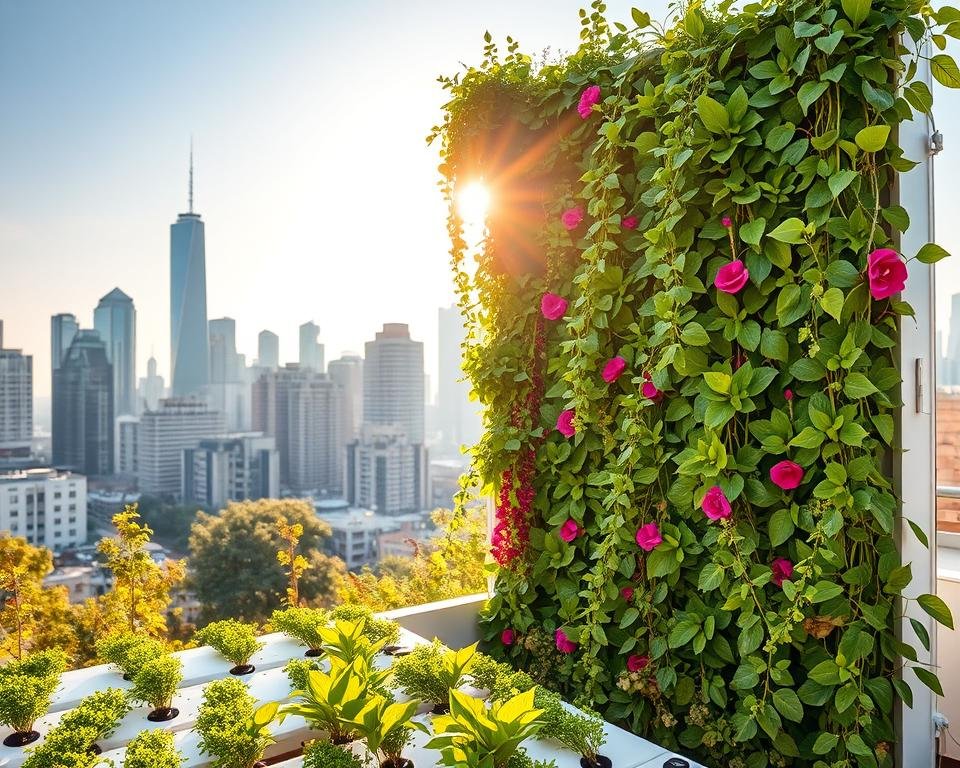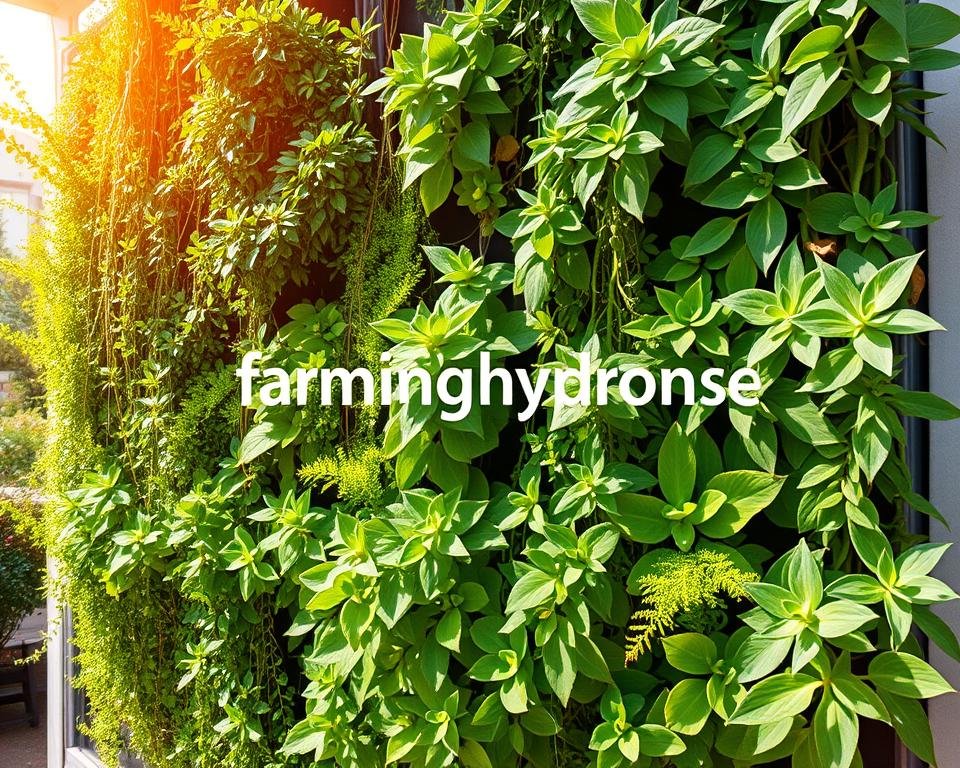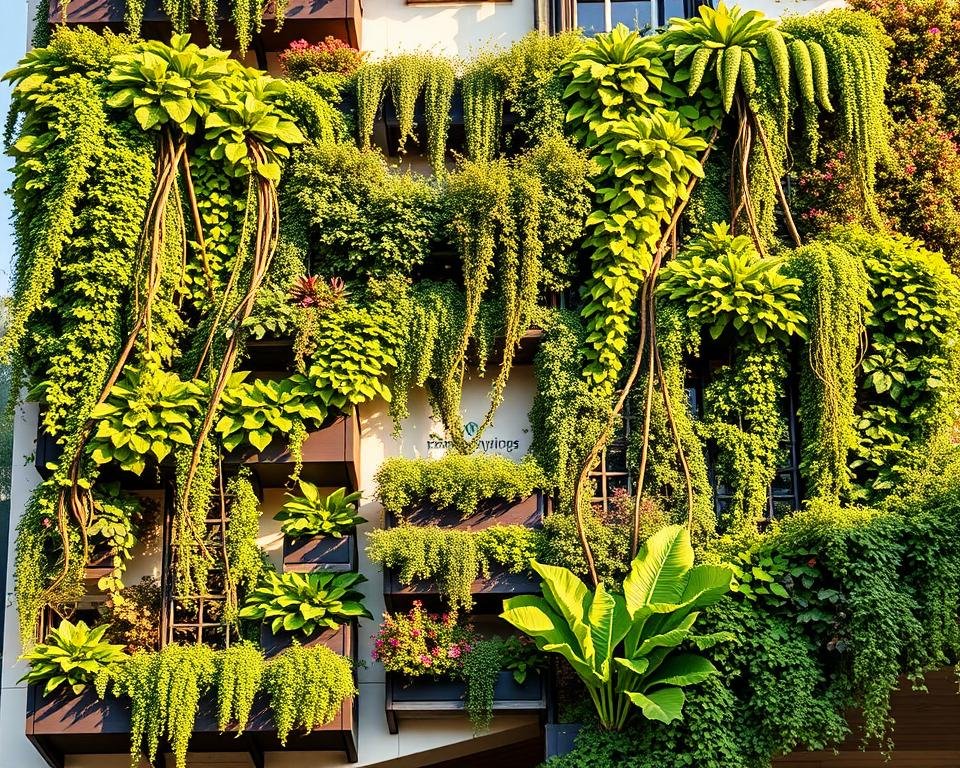Eco-Friendly Design: Sustainable Vertical Gardens
Imagine turning your living space into a lively, breathing world. It’s not just beautiful but also good for the planet. Vertical gardens are a new eco-friendly design. They bring nature right into our cities, making homes greener.
These vertical garden systems do more than look good. They help people in cities use space wisely and care for the environment. They work in homes and offices, changing how we see nature in our buildings.
Vertical gardens use the latest green tech. They turn empty walls into living art. They make the air cleaner, use less energy, and add beauty to any space.
Key Takeaways
- Vertical-gardens offer sustainable solutions for urban spaces
- Minimal maintenance with maximum environmental impact
- Enhances indoor aesthetics and air quality
- Adaptable to various residential and commercial settings
- Contributes to urban biodiversity and green living
Understanding Vertical Gardens: A Modern Green Solution
Vertical-gardens are a new way to make cities greener. They turn blank walls and small spots into lively, green areas. This brings nature right into the heart of cities.
As cities grow, vertical-gardens help use space wisely. They offer a smart way to add green areas without harming the environment. Each system is made to tackle different city problems.
Types of Vertical Garden Systems
There are three main types of vertical-gardens:
- Living Walls: Real plants grow right into the wall
- Hydroponic Systems: Plants grow in water, not soil
- Artificial Green Walls: Use fake or preserved plants for easy care
Key Components and Materials
To make vertical gardens work, you need the right parts:
- A strong frame to hold everything up
- The right soil or growing medium
- A good way to water the plants
- The right amount of light for the plants
Integration with Urban Spaces
Vertical gardens fit well in many city areas. They look good and help the environment. They improve air quality and keep buildings cooler.
Vertical gardens are not just design elements—they’re living, breathing solutions to urban ecological challenges.
Eco-Friendly Design: Principles and Implementation
Creating sustainable vertical gardens needs careful design. It should focus on saving energy and protecting the environment. Your garden can show off biophilic design by choosing materials and methods that are kind to the planet.
Key eco-friendly design principles for vertical gardens include:
- Selecting renewable materials for garden structures
- Using water-conserving irrigation systems
- Choosing native plant species
- Designing for energy efficiency
When designing your garden, pick materials that are good for the environment. Options like recycled plastics, reclaimed wood, and sustainable metals are strong and eco-friendly. Biophilic design aims to blend buildings with nature.
Water management is vital in sustainable gardens. Systems like drip irrigation, rainwater collection, and moisture sensors save water. These methods help gardens use less water and are more durable.
By using these eco-friendly design ideas, your garden will do more than look good. It will actively help the environment.
Environmental Benefits and Sustainability Features
Vertical gardens are a strong answer to urban environmental problems. They bring many benefits that go beyond just looking good. By adding these living walls to your space, you help cut down on carbon emissions and improve the environment.

- They greatly improve local air quality
- They cut down energy use with natural insulation
- They create homes for urban wildlife
- They reduce waste with their sustainable design
Air Quality Enhancement
Vertical gardens act as natural air cleaners. They pull in bad pollutants and send out oxygen. Studies show these walls can take in up to 87% of pollutants from the air.
Temperature Regulation
These gardens also help control temperatures. Buildings with them can use up to 30% less energy. This makes them a smart choice for managing city climates.
Biodiversity Promotion
Urban vertical gardens are key for local wildlife. They provide homes for insects, birds, and small animals. This helps balance out the effects of city life.
Green spaces are not just aesthetic—they’re essential urban infrastructure for environmental sustainability.
By choosing vertical gardens, you’re doing more than just decorating. You’re joining a big push for greener cities.
Installation and Maintenance Best Practices

Creating a successful vertical garden needs careful planning and maintenance. It can turn an ordinary space into a vibrant green ecosystem. Choosing the right location is key for your green building project. It ensures your plants stay healthy and live longer.
Here are important factors to consider when installing your vertical garden:
- Check if the structure can hold the weight
- Look at how much sunlight and wind it gets
- Plan for water to drain well
- Pick materials that help reduce waste
Maintenance is crucial for your vertical garden’s success. Follow these sustainable practices to keep it thriving:
- Water Management: Use smart irrigation systems to save water
- Pest Control: Choose organic, eco-friendly pest control
- Regular Pruning: Trim plants to keep them healthy
- Soil Health: Use organic fertilizers for nutrient cycles
By focusing on sustainable architecture, you can make a vertical garden that’s not just beautiful. It also helps the environment. Your dedication to green building makes a space that’s good for both cities and the planet.
Plant Selection and Growing Methods
Starting a vertical garden means picking the right plants. These choices help reduce harm to the environment. They also turn city areas into lively green spaces.

Native and Adaptive Species
Choosing the right plants is key for a healthy vertical garden. Native plants have big benefits:
- They need up to 50% less water than other plants
- They fit well with the local climate
- They help keep local ecosystems diverse
- They need less care and resources
Sustainable Growing Techniques
Using eco-friendly ways to grow plants helps a lot:
- Organic fertilizers make soil better
- Planting together helps control pests naturally
- Composting cuts down on waste
- It attracts good insects
Water-Efficient Solutions
| Irrigation Method | Water Savings | Efficiency |
|---|---|---|
| Drip Irrigation | Up to 30% | High |
| Rainwater Harvesting | Up to 40% | Very High |
| Sub-surface Irrigation | Up to 50% | Excellent |
“A well-designed vertical garden is not just about aesthetics, but about creating a sustainable ecosystem that supports local biodiversity and reduces environmental stress.” – Urban Ecology Expert
By picking native plants, using green growing methods, and saving water, you can make a beautiful and green vertical garden.
Conclusion
Your journey into sustainable urban gardening is a big step. It helps create green spaces that change both personal areas and the wider environment. Eco-friendly design is more than a trend. It’s a way to bring nature into our modern lives.
Vertical gardens are a smart choice for city folks wanting to lessen their environmental impact. They make spaces look better while helping the planet. By picking native plants and using water wisely, you help improve air quality and add to urban life.
These green spaces do more than look good. They show our commitment to being green, cutting down on carbon and making cities better. Your vertical garden is not just for looks. It’s a way to help nature and show off green building ideas.
As cities grow, vertical gardens show our creativity and care for the planet. By adding these green spots, you’re part of a big effort. You’re making cities stronger and more eco-friendly.







